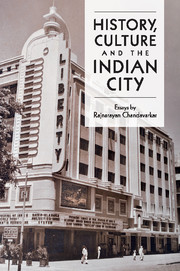Book contents
- Frontmatter
- Contents
- Acknowledgements
- Publisher's note
- Introduction by Dr Jennifer Davis, Wolfson College, University of Cambridge
- Bombay's perennial modernities
- Sewers
- Peasants and proletarians in Bombay city in the late nineteenth and early twentieth centuries
- State and society in colonial India
- Religion and nationalism in India
- From neighbourhood to nation: the rise and fall of the Left in Bombay's Girangaon in the twentieth century
- Historians and the nation
- Urban history and urban anthropology in South Asia
- Aspects of the historiography of labour in India
- Postscript by Professor David Washbrook, Trinity College, University of Cambridge
- Bibliography of the published works of Rajnarayan Chandavarkar
- Index
- References
- Frontmatter
- Contents
- Acknowledgements
- Publisher's note
- Introduction by Dr Jennifer Davis, Wolfson College, University of Cambridge
- Bombay's perennial modernities
- Sewers
- Peasants and proletarians in Bombay city in the late nineteenth and early twentieth centuries
- State and society in colonial India
- Religion and nationalism in India
- From neighbourhood to nation: the rise and fall of the Left in Bombay's Girangaon in the twentieth century
- Historians and the nation
- Urban history and urban anthropology in South Asia
- Aspects of the historiography of labour in India
- Postscript by Professor David Washbrook, Trinity College, University of Cambridge
- Bibliography of the published works of Rajnarayan Chandavarkar
- Index
- References
Summary
The fashion of ‘urban history’ in the 1970s directed attention to the development of transport systems and suburbanization, local government and municipal polities, rural migration and labour markets, commodity trades and industrialization, law-breaking and law enforcement. But it passed by without delving into the question of drains and sewers. Yet to a large extent such simple and underlying issues set limits upon urbanization and the shape of social relations.
This paper seeks to examine more closely the process by which an infrastructure was put together for what was to become one of the world's largest metropolitan centres in the twentieth century: Bombay.
Bombay's beginnings were humble. In 1661, this cluster of seven islands off the west coast of India were acquired by the British as part of Charles II's dowry in his marriage with Catherine of Braganza, and as every chronicler of Bombay's growth has since recorded, there were many who presumed at the time that Britain's new possession lay somewhere in the vicinity of Brazil.
For a century and a half Bombay remained ‘the Cinderella of the English settlements in India: the poorest, unhealthiest and most despised’. For the penurious Company traders who operated from this base, fortunes were less easy to come by than alcoholic fevers and venereal diseases.
Bombay's growth was in its role as the major port for the China trade in cotton and later opium, which, by enabling the Company to pay for its purchases of tea, facilitated the only profitable part of the Company's operations.
- Type
- Chapter
- Information
- History, Culture and the Indian City , pp. 31 - 58Publisher: Cambridge University PressPrint publication year: 2009



